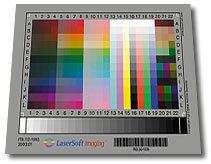 | ||
A color chart or color reference card is a flat, physical object that has many different color samples present. They can be available as a one-page chart, or in the form of swatchbooks or color-matching fans.
Typically there are two different types of color charts:
Color selection charts
Because paints and inks depend for their color on pigments and dyes, a reference is needed to match specific combinations of coloring substances in a given matrix against the resulting color. One of the earliest attempts to achieve this goal was the 1692 manuscript Klaer Lightende Spiegel der Verfkonst. It presented a range of watercolor mixtures, but remained relatively unknown, because only one manuscript was produced. Due to the development of the paint and ink industry, the requirement for this kind of chart intensified, and a number of systems are now available, including:
